FIAT PALIO 2003 178 / 1.G India Version Repair Manual
Manufacturer: FIAT, Model Year: 2003, Model line: PALIO, Model: FIAT PALIO 2003 178 / 1.GPages: 156, PDF Size: 6.27 MB
Page 61 of 156
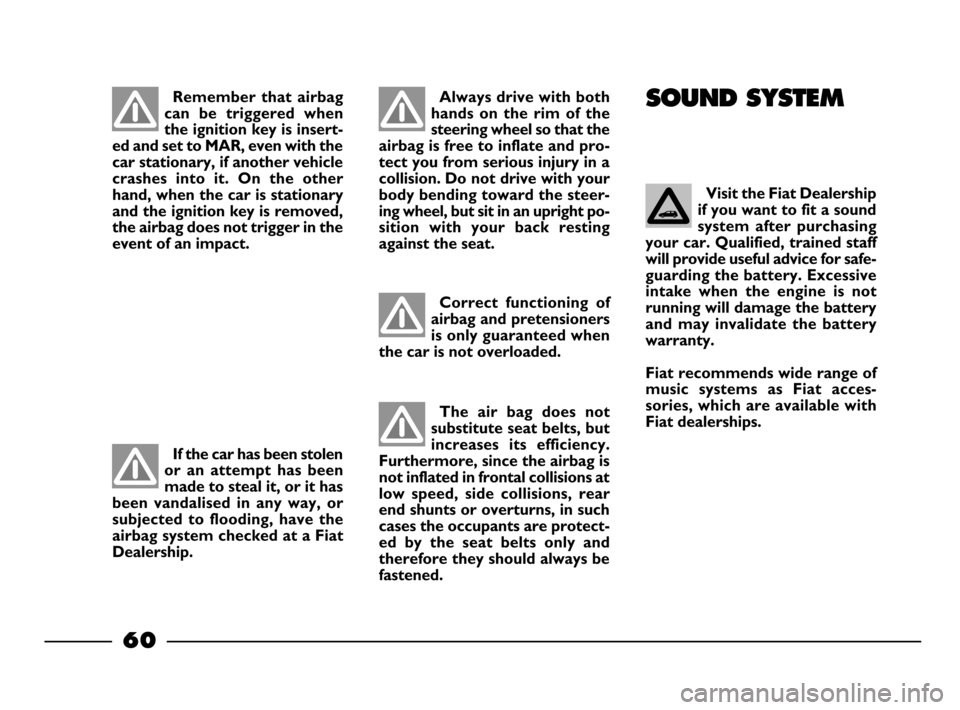
60
Always drive with both
hands on the rim of the
steering wheel so that the
airbag is free to inflate and pro-
tect you from serious injury in a
collision. Do not drive with your
body bending toward the steer-
ing wheel, but sit in an upright po-
sition with your back resting
against the seat.
If the car has been stolen
or an attempt has been
made to steal it, or it has
been vandalised in any way, or
subjected to flooding, have the
airbag system checked at a Fiat
Dealership.The air bag does not
substitute seat belts, but
increases its efficiency.
Furthermore, since the airbag is
not inflated in frontal collisions at
low speed, side collisions, rear
end shunts or overturns, in such
cases the occupants are protect-
ed by the seat belts only and
therefore they should always be
fastened.Correct functioning of
airbag and pretensioners
is only guaranteed when
the car is not overloaded.SOUND SYSTEMRemember that airbag
can be triggered when
the ignition key is insert-
ed and set to MAR, even with the
car stationary, if another vehicle
crashes into it. On the other
hand, when the car is stationary
and the ignition key is removed,
the airbag does not trigger in the
event of an impact.
Visit the Fiat Dealership
if you want to fit a sound
system after purchasing
your car. Qualified, trained staff
will provide useful advice for safe-
guarding the battery. Excessive
intake when the engine is not
running will damage the battery
and may invalidate the battery
warranty.
Fiat recommends wide range of
music systems as Fiat acces-
sories, which are available with
Fiat dealerships.
20-63 03/03/2003 06:03 PM Page 60
Page 62 of 156
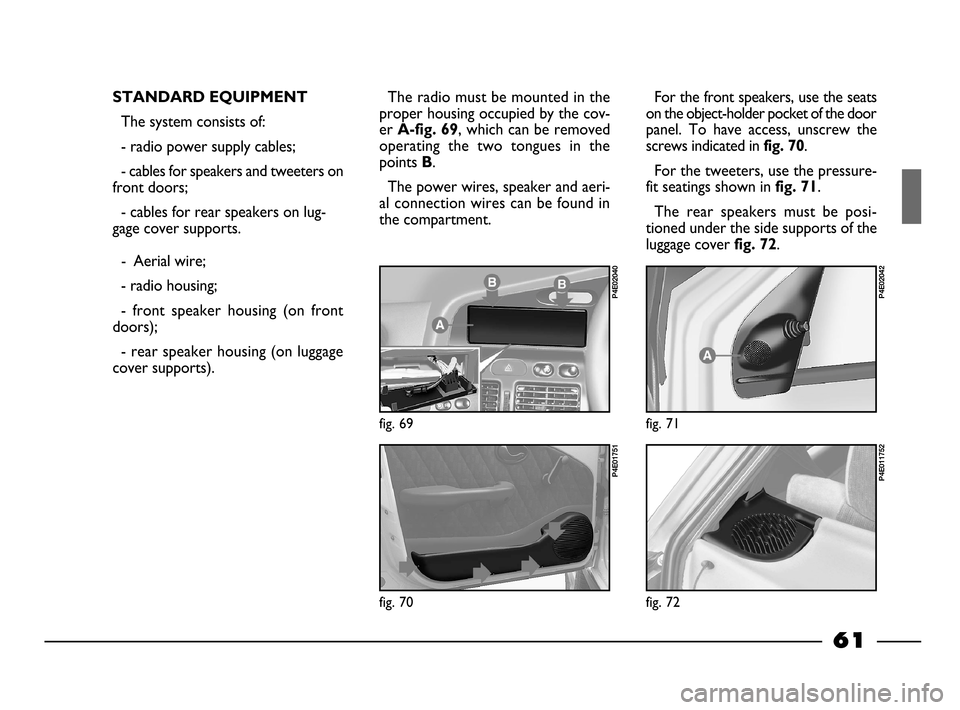
61
STANDARD EQUIPMENT
The system consists of:
- radio power supply cables;
- cables for speakers and tweeters on
front doors;
- cables for rear speakers on lug-
gage cover supports.
- Aerial wire;
- radio housing;
- front speaker housing (on front
doors);
- rear speaker housing (on luggage
cover supports).The radio must be mounted in the
proper housing occupied by the cov-
er A-fig. 69, which can be removed
operating the two tongues in the
points
B.
The power wires, speaker and aeri-
al connection wires can be found in
the compartment.For the front speakers, use the seats
on the object-holder pocket of the door
panel. To have access, unscrew the
screws indicated in
fig. 70.
For the tweeters, use the pressure-
fit seatings shown in
fig. 71.
The rear speakers must be posi-
tioned under the side supports of the
luggage cover
fig. 72.
fig. 69
P4E02040
fig. 70
P4E01751
fig. 71
P4E02042
fig. 72
P4E011752
20-63 03/03/2003 06:03 PM Page 61
Page 63 of 156
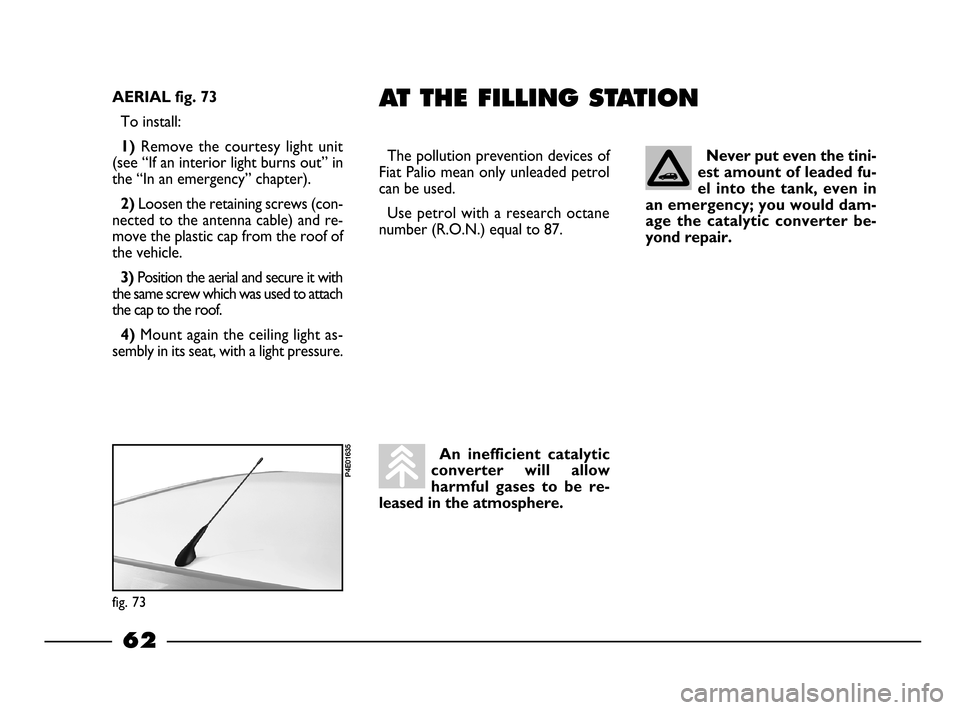
62
AT THE FILLING STATION
An inefficient catalytic
converter will allow
harmful gases to be re-
leased in the atmosphere.Never put even the tini-
est amount of leaded fu-
el into the tank, even in
an emergency; you would dam-
age the catalytic converter be-
yond repair.
The pollution prevention devices of
Fiat Palio mean only unleaded petrol
can be used.
Use petrol with a research octane
number (R.O.N.) equal to 87.
AERIAL fig. 73
To install:
1) Remove the courtesy light unit
(see “If an interior light burns out” in
the “In an emergency” chapter).
2) Loosen the retaining screws (con-
nected to the antenna cable) and re-
move the plastic cap from the roof of
the vehicle.
3) Position the aerial and secure it with
the same screw which was used to attach
the cap to the roof.
4) Mount again the ceiling light as-
sembly in its seat, with a light pressure.
fig. 73
P4E01635
20-63 03/03/2003 06:03 PM Page 62
Page 64 of 156
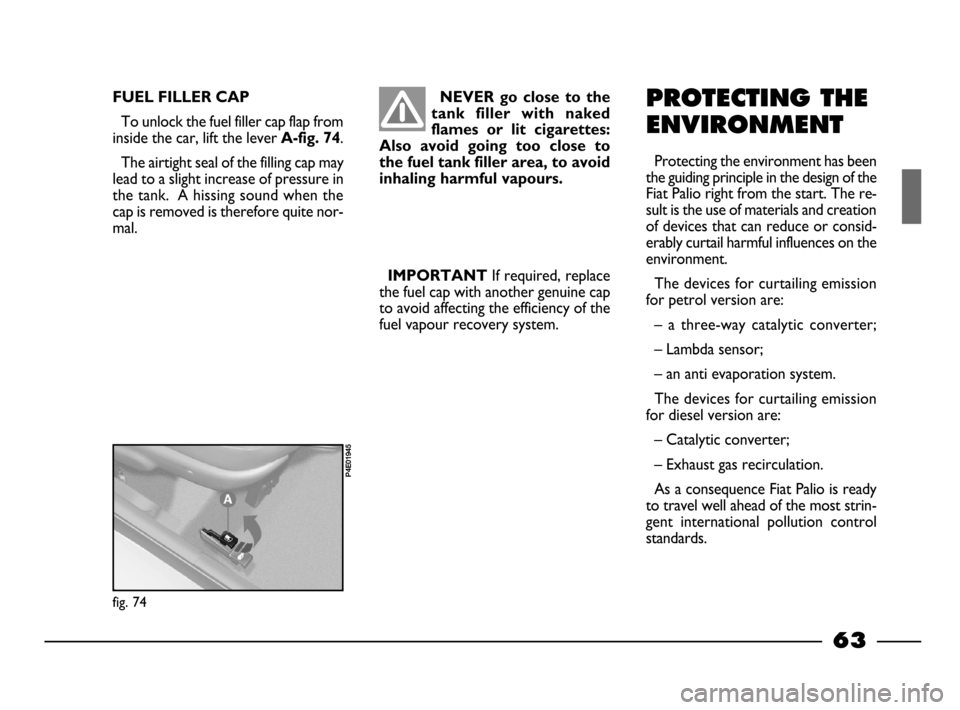
63
PROTECTING THE
ENVIRONMENT
Protecting the environment has been
the guiding principle in the design of the
Fiat Palio right from the start. The re-
sult is the use of materials and creation
of devices that can reduce or consid-
erably curtail harmful influences on the
environment.
The devices for curtailing emission
for petrol version are:
– a three-way catalytic converter;
– Lambda sensor;
– an anti evaporation system.
The devices for curtailing emission
for diesel version are:
– Catalytic converter;
– Exhaust gas recirculation.
As a consequence Fiat Palio is ready
to travel well ahead of the most strin-
gent international pollution control
standards.
fig. 74
P4E01945
IMPORTANT If required, replace
the fuel cap with another genuine cap
to avoid affecting the efficiency of the
fuel vapour recovery system.
NEVER go close to the
tank filler with naked
flames or lit cigarettes:
Also avoid going too close to
the fuel tank filler area, to avoid
inhaling harmful vapours.FUEL FILLER CAP
To unlock the fuel filler cap flap from
inside the car, lift the lever
A-fig. 74.
The airtight seal of the filling cap may
lead to a slight increase of pressure in
the tank. A hissing sound when the
cap is removed is therefore quite nor-
mal.
20-63 03/03/2003 06:03 PM Page 63
Page 65 of 156
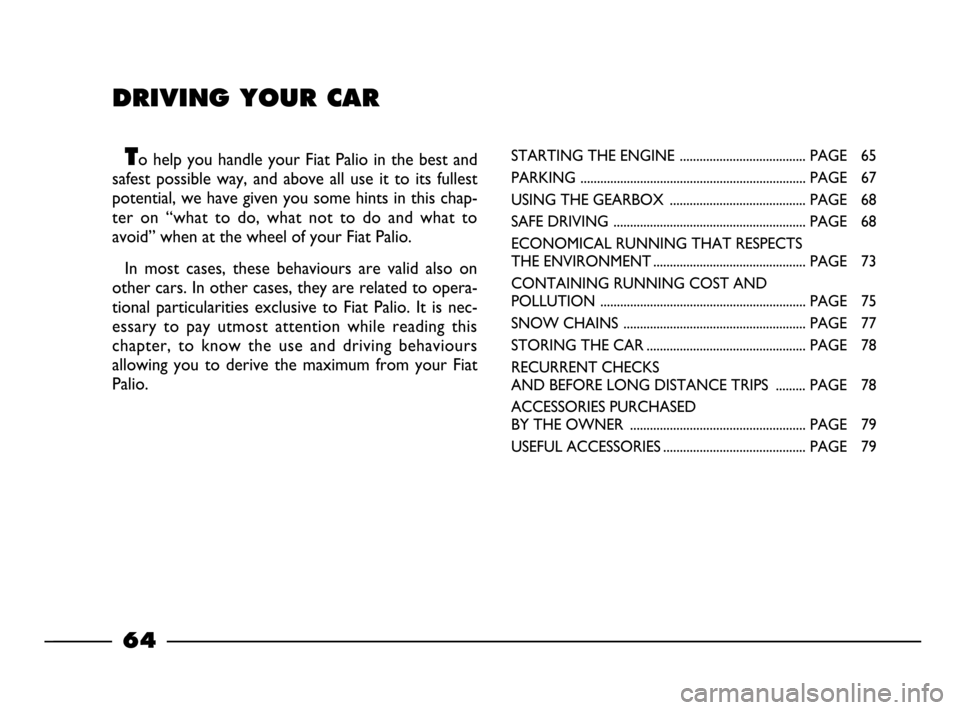
DRIVING YOUR CAR
To help you handle your Fiat Palio in the best and
safest possible way, and above all use it to its fullest
potential, we have given you some hints in this chap-
ter on “what to do, what not to do and what to
avoid” when at the wheel of your Fiat Palio.
In most cases, these behaviours are valid also on
other cars. In other cases, they are related to opera-
tional particularities exclusive to Fiat Palio. It is nec-
essary to pay utmost attention while reading this
chapter, to know the use and driving behaviours
allowing you to derive the maximum from your Fiat
Palio.STARTING THE ENGINE ...................................... PAGE 65
PARKING .................................................................... PAGE 67
USING THE GEARBOX ......................................... PAGE 68
SAFE DRIVING .......................................................... PAGE 68
ECONOMICAL RUNNING THAT RESPECTS
THE ENVIRONMENT .............................................. PAGE 73
CONTAINING RUNNING COST AND
POLLUTION .............................................................. PAGE 75
SNOW CHAINS ....................................................... PAGE 77
STORING THE CAR ................................................ PAGE 78
RECURRENT CHECKS
AND BEFORE LONG DISTANCE TRIPS ......... PAGE 78
ACCESSORIES PURCHASED
BY THE OWNER ..................................................... PAGE 79
USEFUL ACCESSORIES ........................................... PAGE 79
64
64-79 03/03/2003 06:45 PM Page 64
Page 66 of 156
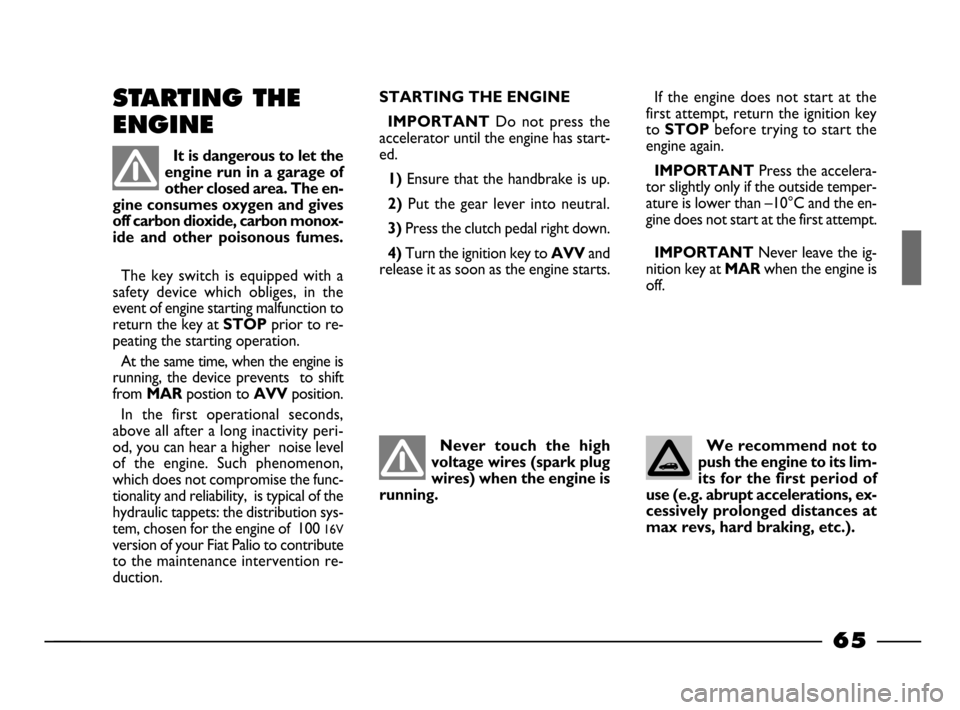
65
The key switch is equipped with a
safety device which obliges, in the
event of engine starting malfunction to
return the key at
STOP prior to re-
peating the starting operation.
At the same time, when the engine is
running, the device prevents to shift
from
MAR postion to AVV position.
In the first operational seconds,
above all after a long inactivity peri-
od, you can hear a higher noise level
of the engine. Such phenomenon,
which does not compromise the func-
tionality and reliability, is typical of the
hydraulic tappets: the distribution sys-
tem, chosen for the engine of 100
16V
version of your Fiat Palio to contribute
to the maintenance intervention re-
duction.
STARTING THE ENGINE
IMPORTANT
Do not press the
accelerator until the engine has start-
ed.
1) Ensure that the handbrake is up.
2) Put the gear lever into neutral.
3)Press the clutch pedal right down.
4) Turn the ignition key to AVVand
release it as soon as the engine starts.If the engine does not start at the
first attempt, return the ignition key
to
STOP before trying to start the
engine again.
IMPORTANT Press the accelera-
tor slightly only if the outside temper-
ature is lower than –10°C and the en-
gine does not start at the first attempt.
IMPORTANTNever leave the ig-
nition key at
MARwhen the engine is
off.
Never touch the high
voltage wires (spark plug
wires) when the engine is
running.
It is dangerous to let the
engine run in a garage of
other closed area. The en-
gine consumes oxygen and gives
off carbon dioxide, carbon monox-
ide and other poisonous fumes.
STARTING THE
ENGINE
We recommend not to
push the engine to its lim-
its for the first period of
use (e.g. abrupt accelerations, ex-
cessively prolonged distances at
max revs, hard braking, etc.).
64-79 03/03/2003 06:45 PM Page 65
Page 67 of 156
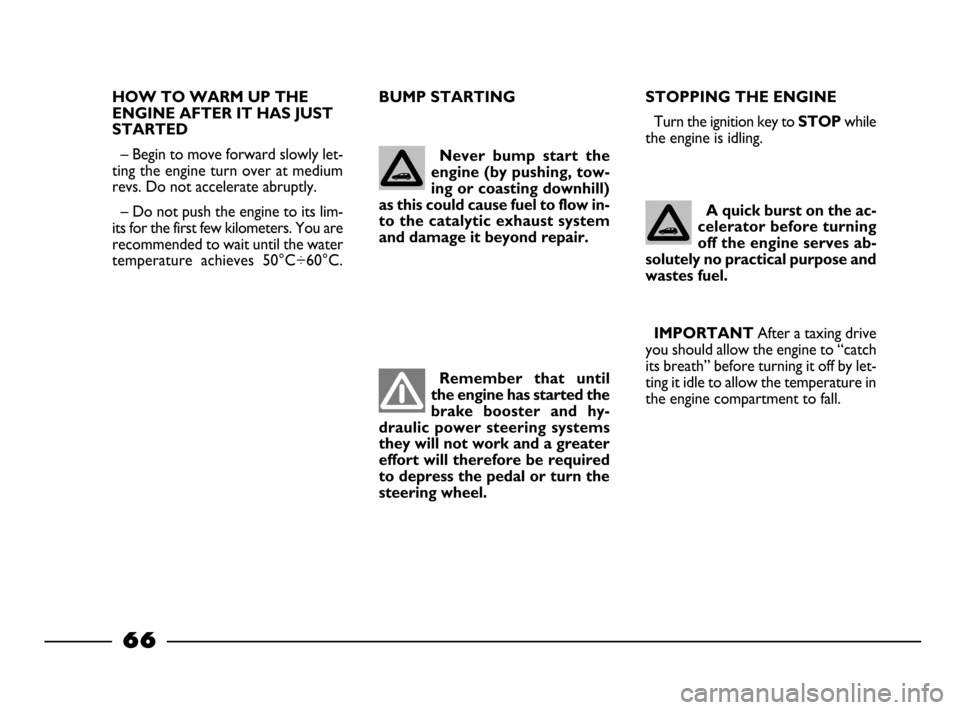
66
BUMP STARTING STOPPING THE ENGINE
Turn the ignition key to STOPwhile
the engine is idling.
HOW TO WARM UP THE
ENGINE AFTER IT HAS JUST
STARTED
– Begin to move forward slowly let-
ting the engine turn over at medium
revs. Do not accelerate abruptly.
– Do not push the engine to its lim-
its for the first few kilometers. You are
recommended to wait until the water
temperature achieves 50°C÷60°C.
Remember that until
the engine has started the
brake booster and hy-
draulic power steering systems
they will not work and a greater
effort will therefore be required
to depress the pedal or turn the
steering wheel.Never bump start the
engine (by pushing, tow-
ing or coasting downhill)
as this could cause fuel to flow in-
to the catalytic exhaust system
and damage it beyond repair.
A quick burst on the ac-
celerator before turning
off the engine serves ab-
solutely no practical purpose and
wastes fuel.
IMPORTANT
After a taxing drive
you should allow the engine to “catch
its breath” before turning it off by let-
ting it idle to allow the temperature in
the engine compartment to fall.
64-79 03/03/2003 06:45 PM Page 66
Page 68 of 156
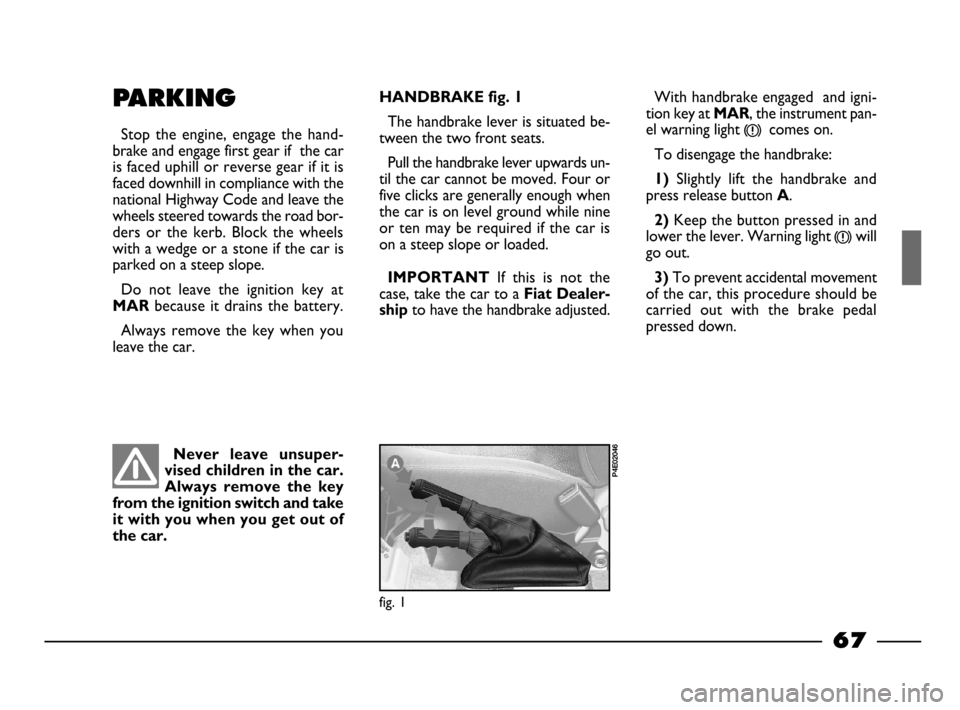
67
With handbrake engaged and igni-
tion key at
MAR, the instrument pan-
el warning light
x
comes on.
To disengage the handbrake:
1)Slightly lift the handbrake and
press release button
A.
2)Keep the button pressed in and
lower the lever. Warning light
x
will
go out.
3)To prevent accidental movement
of the car, this procedure should be
carried out with the brake pedal
pressed down.
HANDBRAKE fig. 1
The handbrake lever is situated be-
tween the two front seats.
Pull the handbrake lever upwards un-
til the car cannot be moved. Four or
five clicks are generally enough when
the car is on level ground while nine
or ten may be required if the car is
on a steep slope or loaded.
IMPORTANTIf this is not the
case, take the car to a
Fiat Dealer-
ship
to have the handbrake adjusted.
Never leave unsuper-
vised children in the car.
Always remove the key
from the ignition switch and take
it with you when you get out of
the car.
fig. 1
P4E02046
PARKING
Stop the engine, engage the hand-
brake and engage first gear if the car
is faced uphill or reverse gear if it is
faced downhill in compliance with the
national Highway Code and leave the
wheels steered towards the road bor-
ders or the kerb. Block the wheels
with a wedge or a stone if the car is
parked on a steep slope.
Do not leave the ignition key at
MARbecause it drains the battery.
Always remove the key when you
leave the car.
64-79 03/03/2003 06:45 PM Page 67
Page 69 of 156

68
You must press the
clutch fully down to
change gear properly. It is
therefore essential that there is
nothing under the pedals. Make
sure that mats are lying flat and
do not get in the way of pedals.
SAFE DRIVING
In designing the Fiat Palio, Fiat made
every effort to offer a car able to pro-
vide driver and passengers with top
class levels of safety.
Nevertheless it is always the behav-
iour of the person at the wheel that
determines road safety.
Below you will find some simple tips
to help you travel in safety under dif-
ferent conditions.
You will no doubt be familiar with
many of them already but it will be
useful to read them all carefully.
USING THE
GEARBOX
To engage the gears, press the clutch
pedal fully down and put the gear lever
into one of the positions shown in the
diagram in
fig. 2(the diagram is also
on the gear lever knob).
To engage the reverse gear (
R), wait
that the car has stopped moving com-
pletely; from the neutral position, lift
the ring
Aof the reverse gear inhibitor
device, move the lever towards the
right side and then backwards.
fig. 2
P4E02289
IMPORTANTThe car can be put
into reverse gear when it has stopped
moving completely. With the engine
running, before engaging the reverse
gear, wait at least 2 seconds with the
clutch pedal fully down to prevent
damage and grating of the gears.
64-79 03/03/2003 06:45 PM Page 68
Page 70 of 156
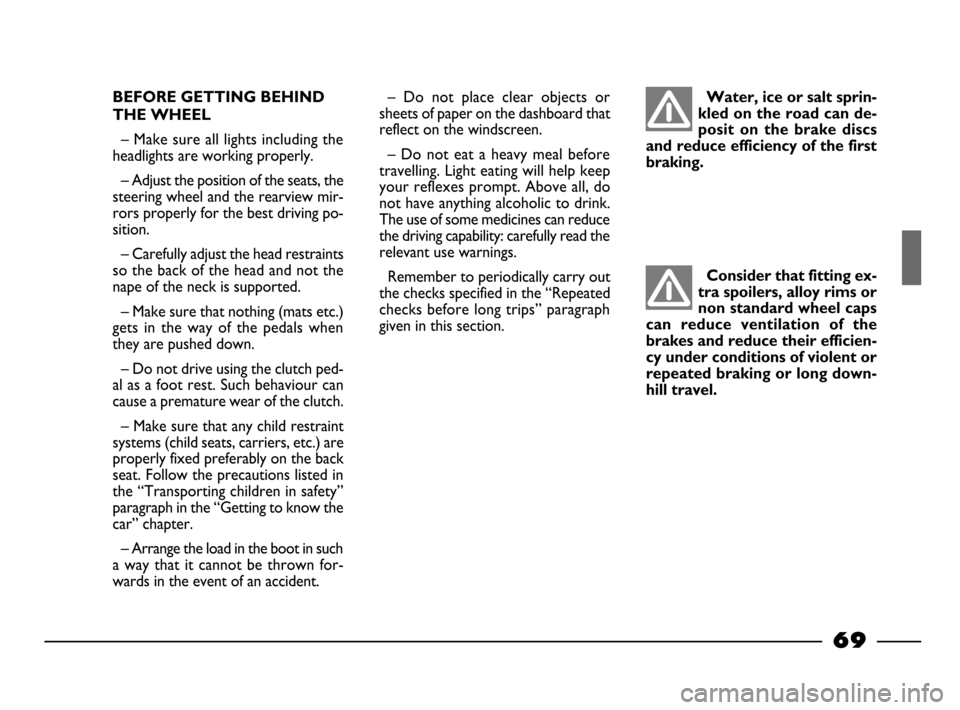
69
Water, ice or salt sprin-
kled on the road can de-
posit on the brake discs
and reduce efficiency of the first
braking.
Consider that fitting ex-
tra spoilers, alloy rims or
non standard wheel caps
can reduce ventilation of the
brakes and reduce their efficien-
cy under conditions of violent or
repeated braking or long down-
hill travel.
BEFORE GETTING BEHIND
THE WHEEL
– Make sure all lights including the
headlights are working properly.
– Adjust the position of the seats, the
steering wheel and the rearview mir-
rors properly for the best driving po-
sition.
– Carefully adjust the head restraints
so the back of the head and not the
nape of the neck is supported.
– Make sure that nothing (mats etc.)
gets in the way of the pedals when
they are pushed down.
– Do not drive using the clutch ped-
al as a foot rest. Such behaviour can
cause a premature wear of the clutch.
– Make sure that any child restraint
systems (child seats, carriers, etc.) are
properly fixed preferably on the back
seat. Follow the precautions listed in
the “Transporting children in safety”
paragraph in the “Getting to know the
car” chapter.
– Arrange the load in the boot in such
a way that it cannot be thrown for-
wards in the event of an accident.– Do not place clear objects or
sheets of paper on the dashboard that
reflect on the windscreen.
– Do not eat a heavy meal before
travelling. Light eating will help keep
your reflexes prompt. Above all, do
not have anything alcoholic to drink.
The use of some medicines can reduce
the driving capability: carefully read the
relevant use warnings.
Remember to periodically carry out
the checks specified in the “Repeated
checks before long trips” paragraph
given in this section.
64-79 03/03/2003 06:45 PM Page 69